Shopify Payments vs Stripe Comparison: Which is Best in 2024?

In the age of online business, it’s essential to have a streamlined and secure payment system to reach customers globally. Since several options are available in the market, making the right choice can be confusing. This game’s top two popular picks are Shopify Payments vs Stripe since each has unique qualities.
Fundamentally, Shopify Payments is a payment gateway built for stores on Shopify only, offering convenience and seamless integration. It helps businesses handle transactions quickly and smoothly. Meanwhile, Stripe is a flexible and comprehensive payment solution that works with many eCommerce platforms, including Shopify.
In this article, we will look at these two payment gateways side by side in terms of price, features, global reach, and more. Knowing this information will give you an advantage in choosing a proper payment option to make your online transactions smooth and effective. Now, let’s begin and dive into the world of simple payments!
1. Key differences at a glance: Shopify Payments vs Stripe
| Criteria | Shopify Payments | Stripe |
| Definition | A built-in payment processor for Shopify platform users, offering convenience and security for accepting online payments. | A third-party payment processor for various eCommerce platforms, offering flexibility and advanced features for online payments. |
| Integration | Seamlessly integrated with Shopify stores; no external setup required beyond Shopify platform configuration. | Requires integration but offers extensive documentation and support for various platforms and languages. |
| Pricing | No additional transaction fees for using Shopify Payments, but credit card rates apply and vary by plan. | 2.9% + 30¢ per successful charge (for domestic cards). |
| Features | Basic features: – Fraud prevention – Dispute management – Fast payouts – Order and payment management – Subscriptions and recurring payments – Shop pay – POS integration | More advanced features: – Payment links and invoices – Donations – Virtual cards – Real-time payments – Advanced fraud detection using Stripe Radar’s machine-learning – 3D Secure – Extensive APIs and SDKs – Identity verification – Data & analytics |
| Supported Payment Methods | – Major debit and credit cards – Wallet payments – International and local payments – Support manual payment for pick-up orders | 100+ payment methods, including:- Cards- Wallets- Bank debits and transfers- Buy now, pay later- Cash-based vouchers- Real-time payment- … |
| Global Reach | – Available in 23 countries – 14 currencies | – Available in 46 countries – 135+ currencies |
| Payout Schedule | Typically 2-3 days in the US, but can vary by country. | Customizable payout schedules, with a default of a 2-day rolling basis in the US but varies internationally. |
| Fraud Filter | Basic fraud analysis included, with Shopify providing support on chargebacks. | Advanced fraud protection tools available (Radar’s machine learning), with detailed chargeback management and support. |
| Chargeback Rate | The chargeback fee on Shopify Payments covers the cost of processing the dispute. If you win the dispute, the fee is returned. | 0.4% per transaction |
| Target Audience | Best suited for merchants already using the Shopify platform looking for a straightforward, integrated payment solution. | Suited for a wide range of businesses, from startups to large enterprises, seeking flexible payment solutions. |
| Pros | Seamless integration with Shopify, no extra transaction fees, simplified chargeback process. | Greater flexibility, supports more payment methods, advanced features, and has a broader global reach. |
| Cons | Limited to Shopify users, available in fewer countries compared to Stripe. | Potentially complex setup for non-technical users, transaction fees may be higher for small transactions. |
In short, the key difference between Shopify Payments vs Stripe is that Shopify Payments is Shopify’s built-in payment processor, designed exclusively for Shopify stores to accept payments easily. Meanwhile, Stripe is a versatile payment processor that can be integrated into a wide range of businesses, not just those on Shopify.
Shopify Payments is ideal for businesses looking for a built-in payment gateway with easy integration. On the other hand, Stripe suits online stores seeking a comprehensive payment solution with flexible customization and advanced features.
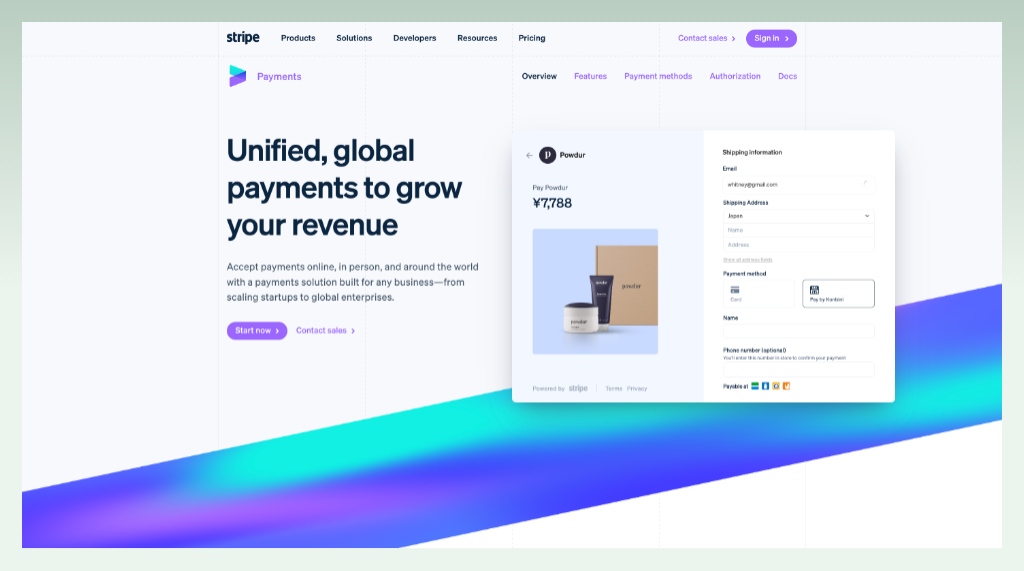
2. Shopify Payments vs Stripe: A comprehensive feature breakdown
2.1. Price
| Criteria | Shopify Payments | Stripe |
| Monthly Fees | – No monthly fees – Shopify’s plan fees apply, starting at $29/month for the Basic plan (yearly paying). | – No monthly fees – Additional fees for premium services such as Stripe Billing. |
| Transaction Fees | No additional transaction fees for using Shopify Payments on Shopify. Credit card rates vary by plan: 2.9% + 30¢ for Basic, lower for higher plans. | 2.9% + 30¢ per successful card charge for online transactions in the US; fees vary by country and payment method. |
| Invoicing | Free for up to a certain number of invoices per month, depending on your Shopify plan; additional fees may apply beyond that. | Free for the first $1 million in revenue processed through invoices; then 0.4% per invoice. |
| Billing | Integrated with Shopify’s billing for subscription and recurring payments, with fees depending on the Shopify plan. | Stripe Billing: 0.5% on recurring charges after the first $1 million in revenue; additional costs for advanced features. |
| Add-ons | Additional features and apps may incur fees; specific rates depend on the services used. | Additional fees for add-ons such as Radar fraud detection and other premium features. |
Our verdict: For small businesses using Shopify, Shopify Payments wins as it typically brings out seamless integration and elimination of additional transaction fees.

2.2. Integration
| Criteria | Shopify Payments | Stripe |
| Ease of Integration | Directly integrated with Shopify stores; no additional setup required beyond Shopify platform configuration. | Requires API integration but offers extensive documentation, SDKs, and libraries for various languages and platforms. |
| Platform Compatibility | Exclusive to Shopify platform users. | Compatible with different e-commerce platforms. |
| Developer Tools | Limited to Shopify’s ecosystem tools and APIs for customizations within Shopify. | Offers comprehensive developer tools, such as APIs and other resources for custom development. |
| Customization | Limited to the features available within Shopify’s dashboard and settings. | Highly customizable checkout experiences, payment flows, and integration with other services or backend systems. |
| Support and Documentation | Shopify’s help center, community forums, and direct support. | Extensive documentation with detailed guides, API references, and support forums, plus direct support for complex issues. |
| Time to Market | Immediate for Shopify users, as it requires minimal setup within the Shopify platform. | Require more time for setup and integration, especially for complex customizations and integrations. |
Our verdict: Shopify Payments wins for online stores operating within the Shopify ecosystem. Stripe is the choice for those seeking customization needs and integration flexibility across different platforms.
2.3. Features
| Features | Shopify Payments | Stripe |
| Invoicing and Payment Links | Not available | Create customizable invoices and payment links |
| Subscriptions and recurring billing | Available through Shopify’s recurring payments and subscription services with additional apps or Shopify Plus. | Native support for subscription billing and recurring payments with advanced customization options. |
| Checkout Customization | Standard checkout process provided by Shopify, with limited customization options unless using Shopify Plus. | Highly customizable checkout experiences, allowing businesses to create a tailored checkout process. |
| Security and Compliance | PCI compliant | PCI compliant, additional KYC/AML checks and 3D secure |
| Marketplace Management | Not available | Facilitate payments between buyers and sellers |
| Reporting and Analytics | Built-in reporting in the Shopify dashboard, providing insights into sales, payments, and more. | Detailed reporting and analytics tools, providing insights into payments, conversion rates, and more, along with data export options. |
| Chargeback Handling | Support for chargeback claims and disputes through Shopify, with documentation and support for merchants. | Advanced chargeback protection and support, including dispute handling tools and detailed documentation for merchants. |
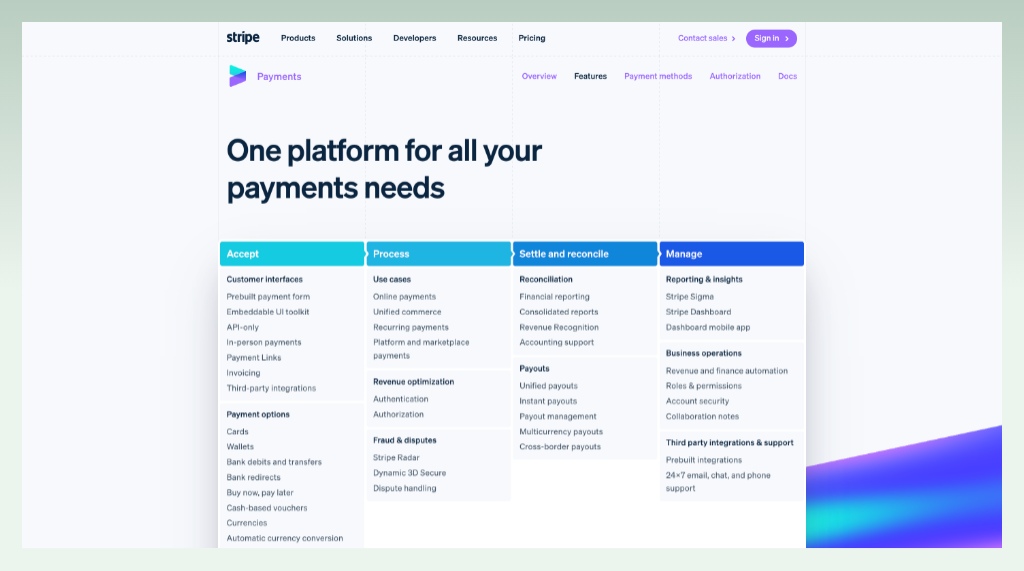
Our verdict: Stripe wins for advanced features and flexibility.
2.4. Supported payment methods
| Payment methods | Shopify Payments | Stripe |
| Cards | Visa, Mastercard, Maestro, American Express, Discover | – Major credit cards: Visa, Mastercard, American Express, Discover, Diners Club, JCB, and more – Debit cards with PIN support for in-person payments – International cards, supporting various currencies |
| Wallets | – Apple Pay – Google Pay – PayPal | – Apple Pay – Google Pay – Samsung Pay – Microsoft Pay – Alipay – WeChat Pay – GrabPay – Afterpay (AU) – Klarna (EU) – Giropay (DE) – iDEAL (NL) – Bancontact (BE) – Sofort (DE, AT) – EPS (AT) – P24 (PL) – MyBank (IT), and more… |
| Bank debits and transfers | Not available | – ACH transfers (US) – SEPA Direct Debits (Europe) – BACS Direct Debits (UK) – Faster Payments (UK) – Giropay (DE) – iDEAL (NL) – Bancontact (BE) – SOFORT (DE, AT) – EPS (AT)- P24 (PL) – MyBank (IT), and more… |
| Buy now, pay later (BNPL) | Not available | – Klarna (US, EU) – Afterpay (US, AU) – Affirm (US) – Splitit (US) |
| Cash-based vouchers | Not available | – Flex Shopper (US) – Synapse (US) – Qwikly (US), and more… |
| Additional methods | – Shop Pay (Shopify’s built-in accelerated checkout) – Local debit cards specific to your country (like Bancontact in Belgium or iDeal in the Netherlands) | – Issuing virtual cards – Real-time payments (RTP) like ACH Instant (US) and SEPA Instant (Europe) – Invoicing – Payment links – Donations |
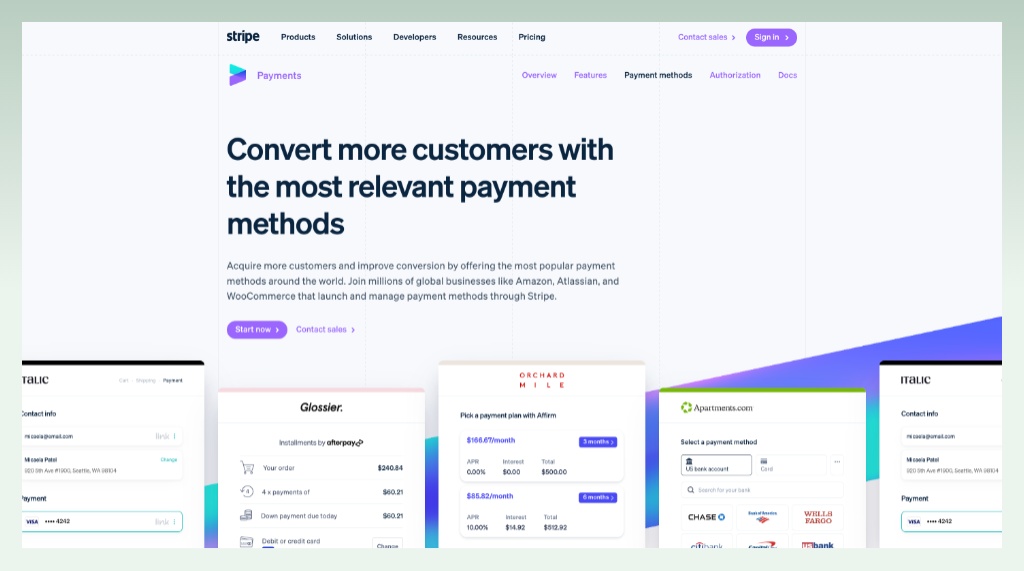
Our verdict: Stripe wins for businesses aiming for global reach and diverse payment options.
2.5. Global reach
| Global reach | Shopify Payments | Stripe |
| Countries supported | Available in 23 countries: 1. Australia 2. Austria 3. Belgium 4. Canada 5. Czechia 6. Denmark 7. Finland 8. France 9. Germany 10. Hong Kong SAR 11. Ireland 12. Italy 13. Japan 14. Netherlands 15. New Zealand 16. Portugal 17. Romania 18. Singapore 19. Spain 20. Sweden 21. Switzerland 22. United Kingdom 23. United States | Supported in 46 countries: 1. Australia 2. Austria 3. Belgium 4. Brazil 5. Bulgaria 6. Canada 7. Croatia 8. Cyprus 9. Czech Republic 10. Denmark 11. Estonia 12. Finland 13. France 14. Germany 15. Gibraltar 16. Greece 17. Hong Kong 18. Hungary 19. India 20. Indonesia 21. Ireland 22. Italy 23. Japan 24. Latvia 25. Liechtenstein 26. Lithuania 27. Luxembourg 28. Malaysia 29. Malta 30. Mexico 31. Netherlands 32. New Zealand 33. Norway 34. Poland 35. Portugal 36. Romania 37. Singapore 38. Slovakia 39. Slovenia 40. Spain 41. Sweden 42. Switzerland 43. Thailand 44. United Arab Emirates 45. United Kingdom 46. United States |
| Currencies supported | Support 14 currencies: 1. Australian dollars (AUD) 2. Euros (EUR) 3. Canadian dollars (CAD) or United States dollars (USD) 4. Czech Koruna (CZK) or Euros (EUR) 5. Krone (DKK) or Euros (EUR) 6. Hong Kong dollars (HKD) 7. Japanese Yen (JPY) 8. New Zealand dollars (NZD) 9. Romanian Leu (RON) or Euros (EUR) 10. Singapore dollars (SGD) 11. Swedish Krona (SEK) or Euros (EUR) 12. Swiss Franc (CHF) or Euros (EUR) 13. Pound sterling (GBP) 14. United States Dollar (USD) | Accept payments in more than 135 currencies. |
Our verdict: Stripe wins for its broader reach, serving different types of businesses with global customer bases.
2.6. Payout schedule
| Criteria | Shopify Payments | Stripe |
| Payout Schedule | Typically 2-3 days in the US, but can vary by country. Some regions may have longer payout periods. | Default is a 2-day rolling basis in the US, with options to adjust frequency. Varies by country and business model. |
| Customization | Limited customization options for payout schedule. Most users must adhere to the standard schedule set by Shopify. | More flexibility in payout schedules: daily, weekly, or monthly payouts, depending on businesses’ choice. |
| Minimum Payout | Varies by country (e.g., $25 for USD) | Not required |
Our verdict: Stripe wins for providing faster payouts and no minimum payout required.
2.7. Fraud filter and chargeback rate
| Criteria | Shopify Payments | Stripe |
| Fraud Filter | Basic fraud analysis tools included, with the option to upgrade for more comprehensive fraud prevention. | Advanced fraud detection with Stripe Radar, utilizing machine learning and customizable rules for dynamic fraud prevention. |
| Price | Free | – Radar’s machine learning: 5¢ per screened transaction- Radar for Fraud Teams: 7¢ per screened transaction |
| Chargeback Rate | The chargeback fee on Shopify Payments covers the cost of processing the dispute. If you win the dispute, the fee is returned. | 0.4% per transaction |
Our verdict: Stripe wins since it uses an advanced fraud detection system, Stripe Radar, to provide a high level of customization for fraud prevention and issues.
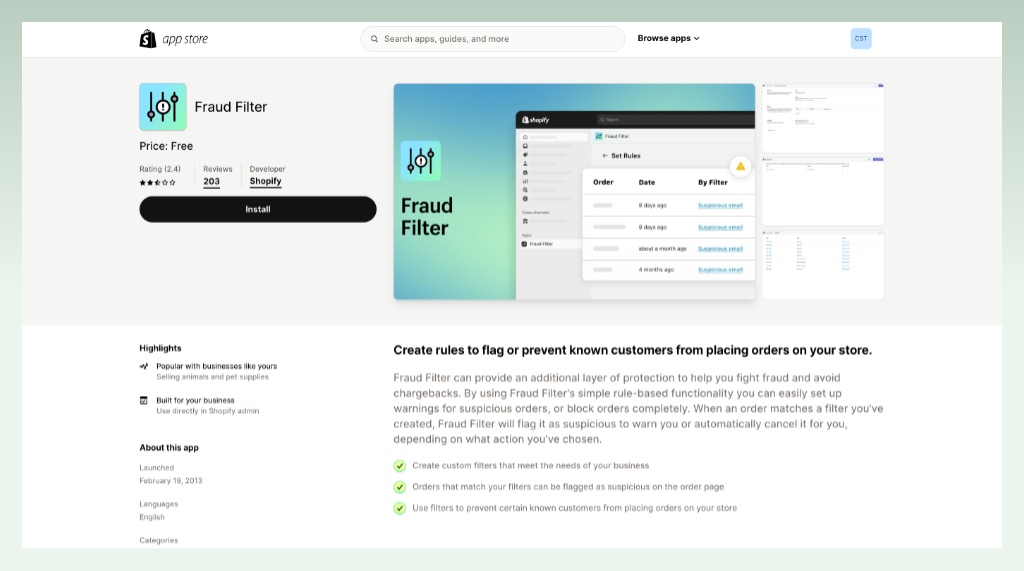
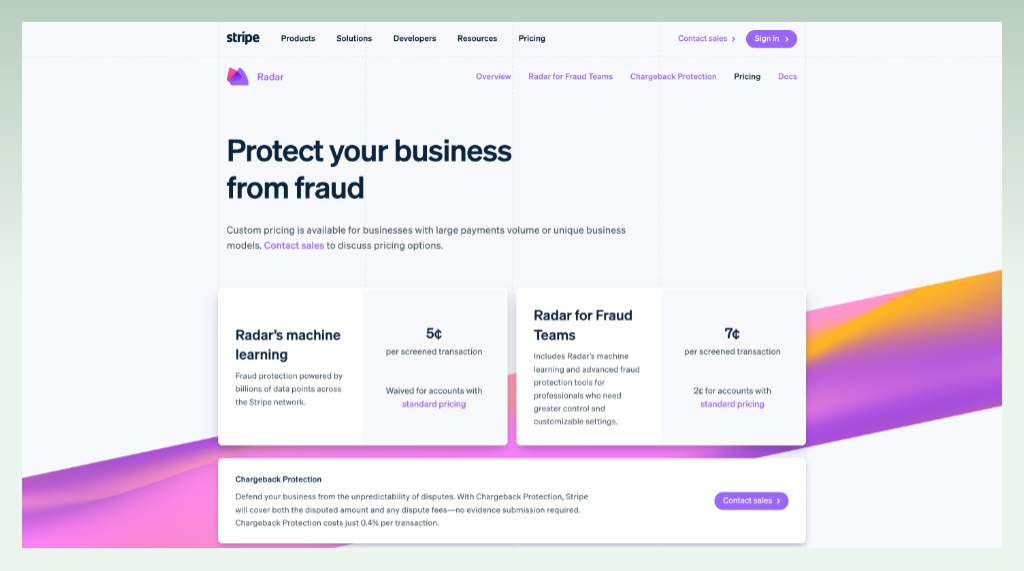
2.8. Ease of use
| Criteria | Shopify Payments | Stripe |
| Setup Process | Integrated directly within Shopify, requiring minimal steps for setup. Just activate it in your Shopify admin. | Requires API integration or setup through the dashboard. Extensive documentation and libraries are provided, but some technical knowledge is needed. |
| User Interface | – Simple user interface, seamlessly integrated into the Shopify dashboard – Easy to manage transactions, view reports, and handle payments. | Clean dashboard designed for both technical and non-technical users. |
| Learning Curve | Low learning curve due to direct integration with Shopify and simplified management features. | Slightly steeper learning curve due to the extensive features and customization options available, but well-documented. |
| Customer Support | Direct support from Shopify for payment-related issues, including access to a comprehensive help center, community forums, and direct support channels. | Offers extensive support through documentation, community forums, and direct support channels, tailored for various technical levels. |
Our verdict: For beginners and businesses solely using Shopify: Shopify Payments wins due to its effortless setup, minimal technical knowledge requirement, and automatic updates.
2.9. Target audience
| Criteria | Shopify Payments | Stripe |
| Ideal for | Online stores using the Shopify platform and looking for a seamless, integrated payment solution. | Businesses of all sizes seeking a flexible, customizable payment gateway to be integrated with various platforms. |
| eCommerce Focus | Specifically designed for Shopify e-commerce platform users. | Broad e-commerce applicability, supporting a wide range of platforms beyond Shopify. |
| Technical Skill Level | Suitable for users with minimal technical skills due to its direct integration into Shopify. | Catered to both technical and non-technical users, but with more benefits for those who can leverage its extensive API and customization options. |
| Business Size | Small to medium-sized businesses that operate on Shopify. | Businesses of all sizes, from startups to large-scale enterprises. |
In short, Shopify Payments is the ideal gateway for online stores using the Shopify platform. It offers seamless payment services ideally suited to the needs of small and medium businesses.
In contrast, Stripe has a broader customer base beyond Shopify users. Its multiple customizing options, widespread covering, and capability to handle many payment methods make it a choice for many businesses, from small stores to large enterprises and across different industries beyond the eCommerce space.
3. Which payment gateway wins? Shopify vs Stripe
3.1. Pros and cons of Shopify Payment
Pros
- Built directly into Shopify, seamless integration
- Accept major payment methods directly within your Shopify store
- Flat-rate transaction fees without hidden charges
- Receive payouts quickly and automatically, typically within 2-3 business days
- Handle chargebacks and disputes directly within Shopify
- Offer Shopify’s accelerated checkout option for a faster and more convenient experience for customers
- Accept in-person payments with Shopify POS and connect sales data seamlessly
- Access business funding without personal credit checks in some regions (eligibility applies)
Cons
- Fewer advanced features compared to competitors like Stripe, lacking invoicing, payment links, and broader international support
- Available in only 17 countries and accepts only 14 currencies
- Only usable with Shopify stores, limiting flexibility if you use other platforms
Choose Shopify Payments if:
- You want a hassle-free payment solution that can be integrated directly into your Shopify store.
- Your small to medium-sized business looking for an all-in-one platform.
- You prioritize lower transaction fees and the convenience of unified management within the Shopify environment.
3.2. Pros and cons of Stripe
Pros
- Highly customizable with extensive APIs and SDKs
- Works seamlessly with Shopify, other platforms, and custom websites
- Supports diverse payment methods (including international options), subscriptions, invoicing, payment links, and more
- Operates in over 37 countries and 135+ currencies
- Stripe Radar utilizes machine learning for robust fraud detection and risk management
- Provides detailed transaction data and reports
- Adapts to your business growth
- Extensive documentation, tutorials, and developer support enable smooth integration and customization.
Cons
- Requires more technical knowledge for advanced features and customization
- Potential development costs due to complex integrations
- Possible higher transaction fees: Businesses with lower transaction volumes may find the standard fee of 2.9% + 30¢ per transaction
Choose Stripe if:
- You want a payment solution that can flexibly integrate across various platforms.
- Your business works on a global scale, and you need support for multiple currencies.
- You prioritize transparent pricing without monthly fees for basic payment services.
- You value customizable fraud prevention tools to enhance your business’s security.
4. Conclusion
Through this comprehensive comparison, eComStart brings you a detailed side-by-side look at Shopify Payments vs Stripe. We highlight how each platform serves different business needs with its unique advantages.
To wrap it up, Shopify Payments is an ideal choice for businesses that aim for a straightforward, integrated solution within the Shopify environment. It’s perfect for smaller businesses with ease of use priority.
Stripe, in contrast, stands out for its ability to cater to a wide array of business demands. It offers exceptional flexibility, support for international transactions, and a wealth of customization options.
So, to make a firm decision for your online store, choosing between Shopify Payments vs Stripe, all you need to do first is think about what your business needs, your budget, and your long-term objectives.


